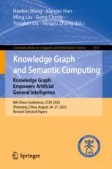Search
Search Results
-
The Study of Causal Nouns in Mandarin Chinese: From the Perspective of Syntactic Realization and Pragmatic Function
Causal nouns can express two types of information, namely, the cause and the effect. These two types of information can be realized in different...
-
A Study on the Recovery of Omitted Constituents in Chinese Elliptical Sentences
Rule-based processing of an elliptical sentence corpus and the construction of a dataset is the basis for various elliptical recovery tasks. We...
-
Zero Anaphora Errors and the Restriction Rules of Zero Anaphora in Discourse for Middle and Senior International Students
Zero anaphora is an important form of textual cohesion in Chinese. However, there have been few previous studies on zero anaphora errors, and the...
-
The Semantic Features and Pragmatic Functions of Cantonese Quasi-Demonstrative Type Quantifier di1: A Comparison with Demonstratives ne1 and go2
The Cantonese collected quantifier di1 exhibits a demonstrative use within the quantifier-noun construction, which results from the...
-
From Blame to Exclamation: On the Lexicalization Mechanism and Syntactic-Semantic Function of Cross-Layer Sequence Form “guài zhǐ guài”
Guài zhǐ guài(怪只怪) is a relatively common and special fixed phrase in modern Chinese oral expressions, which is actually a cross-layer lexical...
-
A New Encoder Using Character and Word Feature Fusion for Chinese Math Word Problem Solving
Automatically solving math word problems (MWPs) aims at generating corresponding math expressions based on the problem text. Since pre-trained...
-
Semantic Analysis of the Tool-Meaning Quasi-Affixes “Jī, Qì, Yí and Jì”
Based on the examination of ancient Chinese language materials, this article further compares the semantic features of the tool-meaning quasi-affixes...
-
On the Discourse Functions of Biede Bushuo Based on Pragma-Dialectical Theory
This study endeavors to elucidate the discourse functions of biede bushuo (别的不说) ‘leaving aside other aspects’ in mandarin Chinese. On the basis of...
-
A Cognitive Approach to the Semantic Change of the Polysemy gàng ‘Wooden Bar’
The semantic meaning of the Chinese word 杠 gàng ‘wooden bar at the front of bed,’ has experienced a long derivational process driven by cognitive...
-
Moral Essential Elements: MEE-A Dataset for Moral Judgement
Moral judgments, including moral polarity judgments, moral intensity judgments, and moral type judgments, are important in hel** people to...
-
Enhancing Semantic Consistency in Linguistic Steganography via Denosing Auto-Encoder and Semantic-Constrained Huffman Coding
Linguistic steganography is a useful technique to hide secret messages within a normal cover text, playing a crucial role in the field of data...
-
A Corpus-Based Study on the Syllablic Form Selection of Ancient Chinese High-Frequency Nouns in the Middle Ages
Polysyllablization was one of the trends governing the development of Chinese lexis, and the Middle Ages, linking the preceding era and the next, was...
-
A Study on the Use and Integration of the Network Buzzword ‘Rùn’
In 2022, the network buzzword Rùn(润) was widely used on the online platform in Puatonghua circles. Its phonetic form is derived from the...
-
Gender Variation in Mix-Gender Conversations in the Semi-institutional Discourse: The Case of Talk Show
In this paper, gender-related variations in the semi-institutional discourse are examined. We investigate the cross-gender conversation in the talk...
-
How Do People React to COVID-19 Vaccination? A Corpus-Based Study of Macau Netizens’ Online Comments
This study draws on corpus methodology to investigate people’s reactions to COVID-19 vaccination using the data of Macau netizens’ comments on a...
-
Taking Comparison Between the Degree Adverbs in Northeast Dialect and Taiwanese Mandarin from Three Perspectives——Taking Lǎo and Chāo as Examples
This paper uses the data from relevant corpora and multimedia resources to summarize the properties and features of the usages of Lǎo (老) and Chāo...
-
Chinese Inter-clausal Anaphora in Causal Relation—A Corpus Study
This research focusing on Chinese inter-clausal subject-subject anaphora in causal relation utilizes a self-constructed corpus to test the validity...
-
Let’s Talk About Business: A Corpus-Based Study of ‘Business’ Related Near-Synonyms and Their Teaching in Chinese as a Second Language
The inherent semantic relatedness and closeness of near-synonyms pose difficulties to second language (L2) learners in comprehending and applying...
-
CCPC: A Hierarchical Chinese Corpus for Patronizing and Condescending Language Detection
Patronizing and Condescending Language (PCL) is a form of implicitly toxic speech aimed at vulnerable groups with the potential to cause them...
-
Towards Better Dialogue Utterance Rewriting via a Gated Span-Copy Mechanism
Dialogue rewriting aims to reconstruct the incomplete utterance from dialogue history. It is a challenge task due to the frequent phenomena of...
